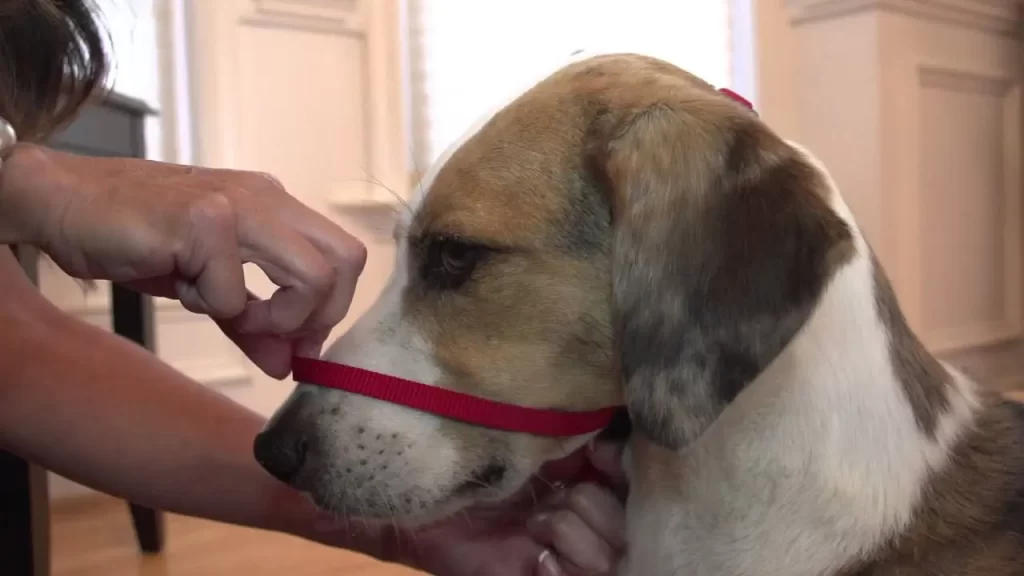
My Dog Still Pulls With Gentle Leader?
This article is about a dog that still pulls on the leash even with a Gentle Leader.
The article discusses how to deal with this problem and what techniques are available.
The Gentle Leader is a head collar that is used as a humane alternative to the traditional choke or prong collar.
It is designed to gently guide dogs by putting pressure on their nose and not their neck.
The Gentle Leader should not be confused with head collars that are designed for horses, which have straps around the top of the dog’s neck instead of around the snout.
The Gentle Leader may also be used to prevent dogs from pulling when on walks, and it can also be used as an alternative for dogs who are anxious about other things like thunderstorms or fireworks.
Why Dog Still Pulls With The Gentle Leader?
Before we dive into the ways to stop your dog from pulling on the Gentle Leader, let’s take a step back and look at why dogs pull in the first place.
It turns out that a lot of the time, dogs have very good reasons for pulling. Figuring out what is causing this behavior can help you stop your dog from doing it.
It’s normal canine behavior for dogs to pull on the Gentle Leader, but this isn’t always desirable. It is a natural reaction for them to want their way and go at their own pace.
Dog’s will naturally pull on the Gentle leader because they want to go the direction that their nose is telling them, and often those directions aren’t where you want them to go.
On the flip side, if you’re teaching your dog to walk nicely on the Gentle Leader and they start taking the lead, this is actually a sign that they’re progressively improving at understanding how to walk on a leash.
Dogs who always pull on Gentle leader will find it difficult to make a habit of not pulling. Pulling is what they’re used to and we need to encourage restraint.
A dog’s natural instinct is to oppose being restrained, but training them with treats will help break the automatic pull-behaviour.
But if you’re dedicated, you can break this habit and over time put an end to all the pulling. This will work by rewarding your dog more when they walk next to you than when they pull.
Methods Use to Stop Pulling With Gentle Leader
1. Choose A Method And Stick With It
The first step to teaching your dog not to pull on the Gentle leader is being consistent. Pick one walking method and be disciplined with it.
Keeping your dog on a Gentle leader and consistent when walking will ensure that it does not do anything deemed unacceptable during the walk.
Teaching behaviors and then being clear about what is okay can be a good way to set expectations for both you & them.
You can have your dog walk on your right or left side, depending on the situation: in close quarters so you have a clear view, or if it’s safe for them to come up ahead.
For situations with differing levels of safety for the dog, try switching their position halfway through the walk.
If you want your dog to always walk on your left side, make sure the person who walks him sticks to the pattern.
Make sure not to keep changing the rules and your walk will go smoother. Always use the same commands and be clear with what you want them to do.
2. Start Training in a Not So Exciting Area
It’s not uncommon for pet owners to try too hard, which is the opposite of what you want to do when using a Gentle leader. Setting them up for success from the very start is essential.
Say your goal is to teach your dog to stay calm and walk nicely. When you are training it away from home, try using an area that will not excite or stimulate the dog. This way, they will be better at staying calm when they get back home.
For example, you could walk around with your dog during midday when most people are working, or schedule a walk during dinner time when people would be eating at home. Alternatively, you can take your dog to a less busy park.
Dog parks are often crowded and noisy, and exploration is a natural part of canine behavior. Your dog may be too distracted to learn or form positive associations at first.
Your dog will be far too stimulated by all the exciting sounds, smells and sights to be able to focus on the task at hand.
It’s important to lead by example and show your dog what you want him to do. The best way to start is to walk nicely in an area without distractions. You can build up from there
3. Use Treats For Good Behavior
When using the Gentle leader to stop your dog from pulling, it’s important to keep them motivated. Eye contact and praise go a long way.
You need to identify the right triggers in order to get your dog to walk politely. For example, give them a treat every time they do what you want them to.
Training dogs to walk with a Gentle leader is challenging for both humans and animals.
You can help yourself by rewarding their good behavior, with tasty treats or even verbal praise.
So when you start teaching your dog to stop pulling while on a Gentle Leader, always use treats or toys to reward them for following you!
When they see that walking nicely without pulling leads to good things happening, they’ll soon start doing it on their own.
4. Use A Normal Pace While Walking
You should start walking your dog by starting at a normal pace and having strides that are appropriate for them.
If you have a smaller dog, you would generally walk at a slower pace. This is because with a shih tzu, for example, you may take shorter steps than if walking with a larger dog.
To get your dog to stop pulling, you can add a cue word like “easy!” and reward their behavior when they take a step back or turn towards you.
5. Change Your Pace
As you progress with your training, some great variations you can use are changing between either a faster or slower pace.
A change in pace is never a bad thing. Mixing up speed and direction can help your dog learn positioning, keep him interested and make an easy overall training plan more effective.
6. Turns: Helps a Dog Learn Not to Pull On Gentle Leader
It’s possible to do a U-turn. Do a 180 degree turn in the opposite direction from where you were walking
I’ll say “let’s go” just before I make a turn so that the dog will keep its focus on the direction we’re headed in. You can add a left or right turn here and here
When beginning to train your dog, make a few turns around a room at first. When turning, don’t pull on the Gentle leader.
It’ll take a few sessions to build up the variety of turns your dog knows.
I turned a lot with my dog Jesse. She often leads the way and tends to forge ahead, so I would teach her not to pull ahead by making these turns.
7. Teach Them How To Heel
Heeling is when your dog is next to your left leg, with his/her neck aligned with you. If you want, he can learn this positioning on the right side too.
Dogs need to learn how to heel before they are able to work with commands and impulses, so I only start a training process once the dog has mastered heeling.
For example, I could do a little more heeling on my walk in order to have them perfect impulse control, but not during the entire duration of the walk.
8. Use Short Training Sessions
When you are ready to begin using the Gentle Leader, start out with small sessions of around 5-10 minutes.
Make it easy for the dog to learn: Keep your training sessions in a calm environment with minimal distractions. It’s also a good idea to start inside so your dog can focus.
When your dog is learning to understand what “let’s go” means, the training should be done in places that are less distracting like your living room.
After he’s learned those basic commands, you can train him in different locations and environments such as the yard or a park.
On a walk, once he understands the basics of these commands, walking outside with the Gentle Leader will become much easier.
What Not To Do When Your Dog Still Pulls With Gentle Leader?
There are some techniques and training methods that can hinder your progress. They are inappropriate and even harmful in some instances.
Don’t Hold the Leash Tight
It’s a common misconception that when you hold the dog’s leash tightly, it will help them not pull. This often leads to more pulling.
If your dog pulls when on a Gentle leader, it’s because of the opposition reflex. This reflex occurs automatically and will continue even if they seem like they’re choking.
Don’t Be Inconsistent
Don’t let the dog pull constantly, but rather only some of the time.
Don’t Use Longlines or Flexis
For the best walk, you should use the shortest leash possible – never longer than 6ft.
You need to hold the leash and give them a little room to move. This isn’t recommended for a long line.
Flexi leashes can be dangerous. They can cause injury to the person or the animal, and their plastic handle can make matters worse.
Don’t Use Painful or Harsh Methods
Be gentle with a dog while training by not jerking the Gentle Leader. This avoids all the negative side effects, like physical harm, choke, prong, or electric collars shouldn’t be used. And don’t yell at him for pulling.
Training should be an enjoyable experience for both humans and dogs. It should strengthen the bond between them, not break it apart with harsh or abusive techniques.
Conclusion
When walking a dog, it is important to teach them not to pull on the Gentle leader.
Not only will this make walks more enjoyable, but it can also lead to safer walks in many cases.
Have you ever trained your dog to walk on a Gentle Leader? What steps did you take?
We want to know your thoughts so please leave a comment below.
